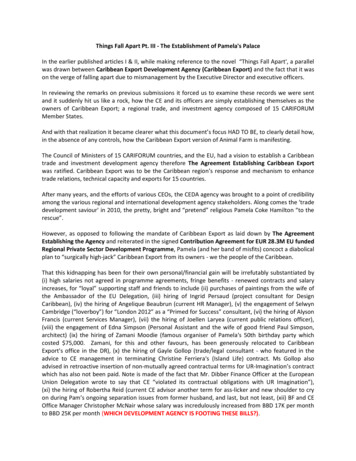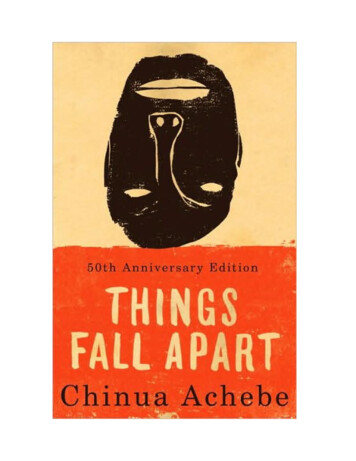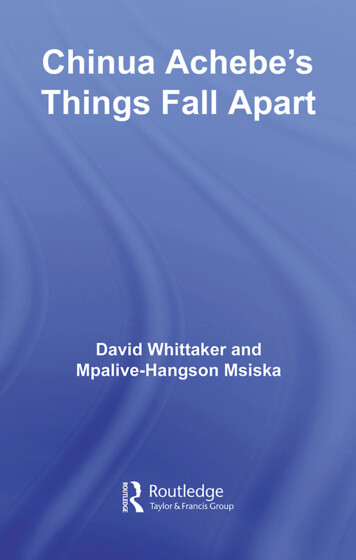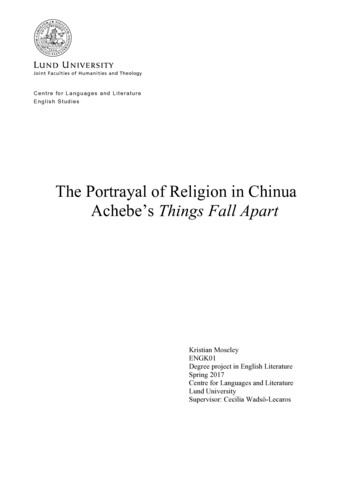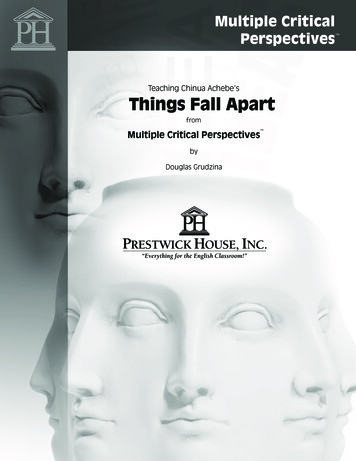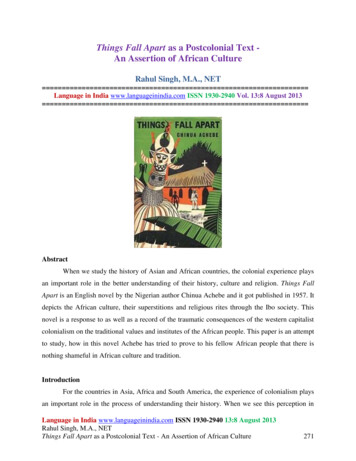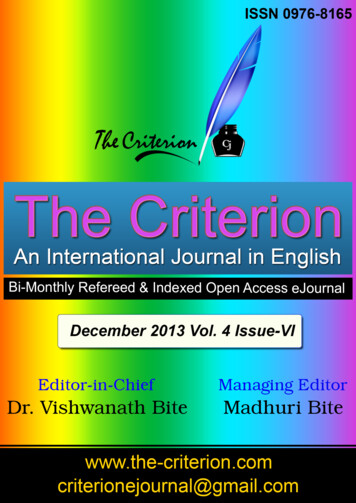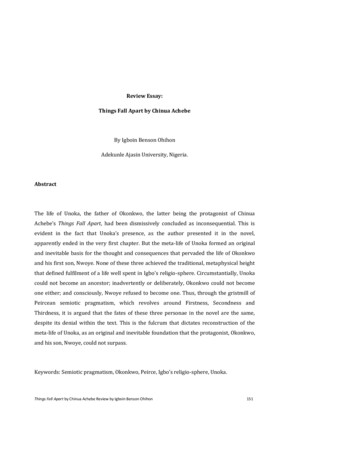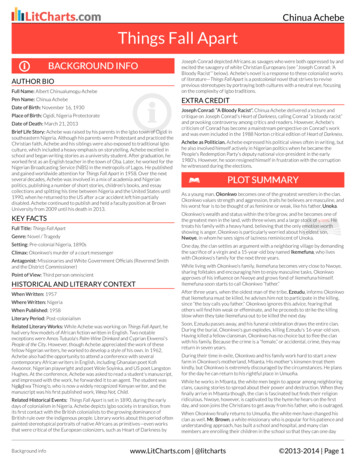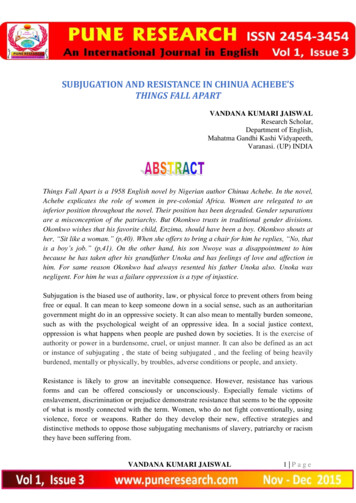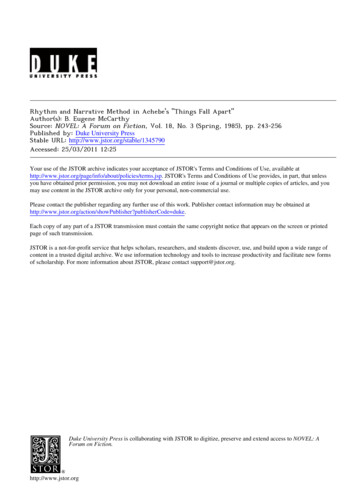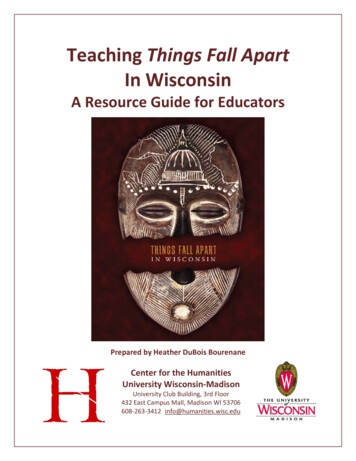
Transcription
Teaching Things Fall ApartIn WisconsinA Resource Guide for EducatorsPrepared by Heather DuBois BourenaneCenter for the HumanitiesUniversity Wisconsin‐MadisonUniversity Club Building, 3rd Floor432 East Campus Mall, Madison WI 53706608‐263‐3412 info@humanities.wisc.edu
Teaching Things Fall Apart in Wisconsin:A Resource Guide for EducatorsContentsIntroduction and Overview: A thematic approachHow to Use this GuideClose Reading StrategiesLesson Plans Include: Objectives, Suggestions for Lectures, Discussion Questions,Activities and Project IdeasUnit 1: Background and Contexts – When Fiction Meets HistoryUnit 2: Social Issues and Religion2A. Igbo Culture and Its Role in the Novel2B. Religion and Society: “The Second Coming”2C. Social norms, caste, and civic structuresUnit 3: GenderUnit 4: Psychology and Character StudiesUnit 5: Power, Knowledge, Education and ReligionUnit 6: Destiny and the role of chi in the novelUnit7: Literary Aspects of the Novel: Form and Structure, Language and StyleUnit 8: Colonial ImpactsUnit 9: Things Fall Apart as tragedyProject Ideas for the Spring Student ConferenceResourcesOnline Resources and Study GuidesBooksVideosMaps of Africa and Nigeria selected handouts and student materials(Additional handouts and readings available online)Note: All of the materials found in this guide are also available online tmlTeaching Things Fall Apart in WisconsinA Resource Guide by Heather DuBois Bourenane
Introduction and OverviewA thematic approach to close readingFirst published in 1958, Chinua Achebe’s Things Fall Apart is easily the most recognizable andwidely taught African novel in the U.S. It has been translated into at least 50 languages, andsold over 10 million copies worldwide, and has appeared on many “greatest books of all times”lists around the world. But why? What is it about this classic story of transformation andtragedy that makes this book so attractive to students and educators? In some ways, the bookhas come to represent Africa as a continent: it serves as a symbol of the injustices ofcolonization and the internal forces that helped lead to the complete take‐over of Nigeria bythe British colonialists. But is has also become a symbol of postcolonial possibility, and theimportant task the African writer takes up when attempting to reclaim or rewrite the stories ofhis or her people. Because of this, educators have a double burden in teaching this highlyteachable book: they must both fully contextualize the novel in its own time and place, andthey must keep central to their approach to the text a constant reminder that while we canlearn much about the truths of the colonial experience through this text, it is a work of fiction,not a historical or anthropological tool for understanding contemporary Africa in all itscomplexity and diversity.To do this, we suggest that the book be taught from a thematic framework which relies on theclose reading of key passages, emphasizing the relationship between the form and content ofthe novel and helping students navigate the development of key characters and themes tonegotiate how they create meaning in a Wisconsin classroom. When taught from thisperspective, the book opens up worlds of opportunities for students to connect to the text,appreciate its great literary merit, and gain a greater understanding of the themes and issuesdeveloped in its pages.How to Use this GuideThe lesson plans and activities provided in this guide are designed to allow you the opportunityto tailor the way you teach the novel to your own course, interests, and goals. The individualunits could be taught over one or several days, and you can mix and match ideas from thevarious sections to put together your own syllabus. Each section includes project ideas,study/discussion questions, and suggestions for further teaching of the theme or issue covered,as well as recommendations for material and concepts to be covered in lecture. Discussionquestions can be used as prompts for in‐class discussion, or for small group activities or in‐classwriting assignments.Logistics for teaching the lessons in this guideThe lesson plans included in this guide have been sorted into nine units that can be taught inany sequence, but all of them except the first two generally assume that students haveTeaching Things Fall Apart in WisconsinA Resource Guide by Heather DuBois Bourenane
completed the entire novel. This guide is designed to accommodate curricula plans that devoteanywhere from two weeks to an entire semester to the novel, and there are basically two waysyou could approach the novel:Option A:Thematic model (read the entire text, then discuss)To ensure that students have time to read the novel, the first two units coverbackground and provide historical and cultural context for the novel, and if youdon’t have time to assign the reading earlier, you could use this time (one to twoweeks) to assign the reading of the entire text, and then use the rest of thelesson plans to focus on specific passages of your choosing. The lesson plansincluded in this guide are designed for teachers using this model, but can easilybe adapted for Option B.Option B:Chronological/linear model (discuss chapter by chapter, or in three parts)You could customize these units by teaching the book by following the novelchronologically, and picking out themes covered in the lesson plans to focus onin each chapter or section. Since most of the themes addressed in Part One arefurther developed in Part Two, you could return to these themes as the studentsfinish the reading. This plan lends itself well to a 3‐ or 4‐week model: Part One ofthe novel – Chapters 1‐13 (p. 3‐125) could easily be read in one week (two if youhave time), and Part Two – Chapters 14‐19 (p. 129‐167) – could be read in weektwo, and Part Three – Chapters 20‐25 (p. 171‐209 ) could be discussed in weekthree. Even with as few as two weeks to teach the novel, you could cover PartOne in week one and Parts Two and Three in the second week.Suggested Preparatory Readings and student materials (handouts) areall available online at: xts/things‐fall‐apart/center‐resources.html. While these readings are optional (with the exception of the readings recommended inUnit One), they have been carefully selected to provide background, context and content analysis foreach specific unit and teachers should find them enormously helpful in preparing to teach the book.Homework, Projects and Student Materials (available online)Each unit is accompanied with supplementary materials, study questions and project ideaswhich can be used to develop handouts and classroom aids. After surveying the wealth ofinformation available online for this text, we felt no need to reinvent the wheel in thisdepartment, and point you to handy handouts available online whenever possible. Teachersshould preview these materials carefully however, and make efforts to avoid using materialswhich present the text ahistorically or without taking into account the status of the text asfiction. There are many resources out there and navigating them can be rather overwhelming.Many of these resources tend to present the novel exclusively from an anthropologicalperspective – as an “example” of authentic “African culture.” And while the book does indeedopen up discussions of Ibo life and culture, this is only a small part of the text’s value andprobably one of its more superficial ones at that. It does both the novel and our studentsTeaching Things Fall Apart in WisconsinA Resource Guide by Heather DuBois Bourenane
disservice to allow Ibo culture to stand in for all of African culture, which, it should be stressed,is extraordinarily diverse, even within Nigeria itself. We have made efforts to point you towardthe best web resources we could find on the novel, and encourage you to make use of therecommended materials found in this guide.Close Reading StrategiesMost of the lessons in this guide revolve around or depend upon close reading of specificpassages in the text (of your choice) in order to generate discussion and build meaning as aclass. “Close reading” here means careful examination of a portion of the text, whichemphasizes the particular over the general and uses textual evidence to support one’sinterpretation. Close reading works best when the selected passage is either read aloud ordistributed as a handout, and accompanied by discussion questions. It also lends itself well togroup work and small‐group discussions, and is an excellent way for students to learn bothcritical thinking and analysis skills as they make connections, use evidence to support theirviews, and discuss the impact of fiction. For close reading to work successfully, it’s importantthat the teacher always remind the students to point to the passage/line/phrase/word thatsupports their position as they share their ideas. Close reading teaches students the differencebetween “opinion” or “personal reaction” and “analysis.”Lecture PointsEach unit in this guide contains a set of lecture points. These are the ideas and concepts werecommend you cover in class, but you should feel free to add, adjust and customizes theseideas to fit your own goals and objectives for the unit. Since every teacher has a differentteaching a preparation style, we just provide some basic tools here – the goal was to provideenough information that teachers who wanted to could construct an entire unit out of thematerials, but leave room for flexibility and adaptation to different course and teaching needs.Whatever your approach, lecture should always model the sort of close reading you want thestudents to perform by using as many examples from the text as possible to support andreinforce your points.A Note of Caution on PlagiarismAs with other “great texts,” there is a wealth of information readily available on Things FallApart, which can be tempting material to plagiarize from the web or other study guides.Teachers may consider discussing their policies on academic honesty and the differencesbetween paraphrasing, summarizing, citation and undocumented use of other sources. It’s alsorecommended that teachers make plagiarism less likely by customizing their assignments totheir classes and avoiding generic and widely‐used prompts for take‐home essay assignmentsor longer projects.For further informationIf you have any questions about this guide, or would like additional information on any of thematerials included here, please feel free to contact the author, Heather DuBois Bourenane, atTeaching Things Fall Apart in WisconsinA Resource Guide by Heather DuBois Bourenane
hldubois@wisc.eduor(608)Teaching Things Fall Apart in WisconsinA Resource Guide by Heather DuBois Bourenane825‐2518.
Lesson Plans and ActivitiesUnit 1: Background and Contexts – When Fiction Meets HistoryWhile it offers a certain perspective on colonial history, Things Fall Apart is not a strictlyhistorical novel. Historical novels, by definition, fictionalize historic events and bring them tolife with invented details, characters, dialogue, etc. And while Things Fall Apart does situateitself within a specific historical context (Nigeria at the moment of colonization), it does notattempt to recreate actual events or re‐characterize real historical figures. In other words, whileit is engaged with the historical theme of colonialism in Nigeria and Igbo culture, it is whollyfiction, and should be understood and taught as such. In addition, it is very important to keep inmind the historicity of the novel itself: the book is set in the 1890s, but was first published in1958, 2 years before Nigeria was granted full independence from British rule. This means thatwe are bringing a postcolonial sensibility and perspective to the text and should bear in mindthe many ways in which Nigerian politics, culture and attitudes have changed in the last 50years. So the novel is not wholly historical, nor wholly contemporary, as much as it can help uslearn about both the past and understand themes of value to the present.Objective:Introduce students to the role of fiction in understanding colonial history, and providebackground and context for the novel and the author."The last four or five hundred years of European contact withAfrica produced a body of literature that presented Africa in avery bad light and Africans in very lurid terms. The reason forthis had to do with the need to justify the slave trade and slavery. This continued until the Africans themselves, in the middle ofthe twentieth century, took into their own hands the telling oftheir story."(Chinua Achebe, "An African Voice", The Atlantic)Preparatory Reading:The following three essays by Achebe should be considered required reading before teachingThings Fall Apart:“The Novelist as Teacher” by Chinua Achebe“Teaching Things Fall Apart” by Chinua Achebe“An Image of Africa: Racism in Conrad’s Heart of Darkness” by Chinua OTE: any of these short readings could also be suitable for students,particularly in AP literature or history courses)Teaching Things Fall Apart in WisconsinA Resource Guide by Heather DuBois Bourenane
Additional Readings and Resources: “Chinua Achebe’s Things Fall Apart” by Martin Klein (from African Novels in theClassroom) “Africans Live in Tribes, Don’t They?” by Curtis Keim, Mistaking Africa: Curiosities andInventions of the American Mind (2009) Discussion of Achebe’s response to 7sHeartofDarkness.pdf Nigerian History online:http://news.bbc.co.uk/2/hi/africa/country profiles/1067695.stm African History m211/timelines/htimelinetoc.htm The Story of Africa (African History from an African Perspective on materials The “Teaching Colonial Representation” file (online) includes advertisements, quotesand diagrams of colonial power structures is included Chinua Achebe biography and bibliography handout (online)Lecture points:Using the preparatory materials above, the lecture should contextualize the novel bycovering the following: A brief history of precolonial Nigeria and the colonization of Africa 1958, first publication of Things Fall ApartNigeria: British colony from end of 19th c. until 19601967‐70 Biafran War (Igbo secession)Major ethnic groups (70% of population): Hausa‐Fulani, Yoruba and IgboEst. 2005 pop of Nigeria: 128 millionTumultuous political history since independence; many of Achebe’s other books confrontcorruption in politics, social issues Identify Nigeria on the map of Africa, and the approximate setting for the fictionalvillage of Umuofia in the novelDiscuss the people, languages and religions of Nigeria today, as well as any politicalor popular news you feel is relevant to your courseDiscuss why context is important to understanding the novelProvide background information on Achebe and his life, other works, career, etcBe sure to remind your students to make use of the glossary in the back of the book.Let them know they will be responsible for the terms and concepts Achebe presents.Discussion of the colonialist, Eurocentric representations of African history and howthe novel directly confronts these. Discuss how “history” is an imperfect record of Teaching Things Fall Apart in WisconsinA Resource Guide by Heather DuBois Bourenane
events and is subject to the biases and perspectives of those who record it. Discussthe role of objectivity and integrity in contemporary historiography.This is the perfect opportunity to also set some ground rules as a class for what kindof language is and is not appropriate/respectful when talking about Africa. Using“How To Write About Africa” by Binyavanga Wainaina could be a good way to bringup the issue of stereotypes and misconceptions about AfricaIntroduce the concept of understanding and analyzing fiction and using closereading to create meaning in the Wisconsin classroomDiscuss the author’s contention that his work has (at least partly) a didactic role interms of “re‐teaching” the history of Africa in a more positive light.o Use this idea to discuss: What this means to American readers? Are we “outsiders?” The role of fiction/literature in understanding history Whether or not fiction can “revise” history. What does this reallymean?Discussion Questions: What is fiction? What is history? Find Nigeria on the map of Africa. Discuss its features. Compare contemporary, colonial and pre‐colonial maps of Africa. Discuss theirfeatures. What does “diversity” mean in Nigeria as compared to the US? What are stereotypes? How do certain words promote a negative impression ofAfrica or Africans?o What is problematic about the following terms: tribe, hut, savage, primitive,backward, timeless, primordial, (etc)? Why are these terms problematic?Why might some people find them offensive or disparaging? Who is Chinua Achebe? Who lives in Nigeria? What are the official languages of Nigeria? How many languages are spokenthroughout the country? How many cultural or ethnic groups can you find on themap (see supplementary materials for linguistic and ethnic maps of Nigeria)?Assignment and Project Ideas: Reading/Response Journal. Now is a good time to ask your students to keep areflection journal in which they respond to the text and material covered in class. Youmight design this assignment thematically (by assigning a theme or issue – say “family”or “power”) and ask them to explore how they see that theme reflected in the variousunits you cover. Or you could ask them to simply write 1‐2 pages of personal responseto the text, to find points of identification or highlight confusing or problematicpassages. Or you could use the discussion questions in these lesson plans to create yourown guided journal – a handout of prompts to which you require the students toTeaching Things Fall Apart in WisconsinA Resource Guide by Heather DuBois Bourenane
respond when reading each chapter/section of the novel. This could be an on‐goingproject, a group activity, or an in‐class writing assignment at the end of each classperiod.Have students write an essay in which they reflect on the relationship between historyand fiction, and think of their own example of a “truth” of fiction and a “fallacy” ormisconception of history (e.g. “Christopher Columbus discovered America”).Use the handout/presentation materials in the “Teaching Colonial Representation” file(online) to create an assignment for your students that asks them to reflect on(mis)representations of Africa in the media and popular culture. You might ask them tofind a movie, tv show, advertisement or song that reproduces a negative stereotype andthen relate that to Achebe’s project of combating misrepresentation of African history.Ask students to think of what stereotypes or generalizations are applied to their own[ethnic, cultural, religious, family, social] group and reflect on how/why thosegeneralizations are problematic or misleading.Diversity project: Nigeria’s population is diverse in many ways: ethnically, linguistically,religiously, economically, geographically, etc. To drive home the point that the Ibopeople represented in the book are only one of many cultural groups in Nigeria, andencourage them to learn more about Nigerian culture, have students do some internetresearch to learn more about contemporary (and/or colonial) Nigeria. Have them findvideos of artists or musicians from different linguistic groups so they can hear thedifference in the languages. Ask them to find information on Yoruba cosmology so theycan see how dramatically it differs from the Ibo belief system Achebe depicts in thenovel. Ask them to find articles on current issues, conflicts, politics and events, orpopular literature and culture (television programs, pop music, cartoons, etc). Bringthese to class and discuss how they compare/contrast to the fictional world of thenovel.Suggestions for expanding this unitIf you have time, you could spend an infinite amount of it covering colonial history,postcolonial Africa, and/or the larger topic of representation and stereotypes. There areseveral useful films that could be used in this unit, and you might check out the UW‐Madison’s African Studies Program film collection, which allows you to borrow (free ofcharge). They can even arrange shipping if you’re outside of Madison. Browse thecatalogue at: http://africa.wisc.edu/outreach/catalogue.pdf. To expand the history orbackground units, you might start with some of the web resources provided in thisguide.Teaching Things Fall Apart in WisconsinA Resource Guide by Heather DuBois Bourenane
Unit 2: Igbo Society and Culture in Things Fall Apart2A. Igbo Culture and Beliefs and their Role in the Novel2B. Religion and Society: “The Second Coming”2C. Social norms, Social structuresTitles and casteSocial Structure2D. Cultural contacts and contrasts: What do the Ibo of the story have in commonwith the Europeans in the story? How do they differ?There are many ways that one could approach or introduce the topic of Igbo culture in ThingsFall Apart, but to avoid exoticism or presenting the Igbo characters as “cultural others,” it’srecommended that teachers focus on understanding key cultural concepts that are crucial tothe text’s major themes and plot. Many of these cultural elements – such as the use ofproverbs and storytelling – become themes in the novel which help us make sense of the text’slarger meaning. Looking at the representation of Igbo culture as part of the text’s larger project– as opposed to being “cultural tourists” in the fictional landscape of the novel – provides aproductive framework for understanding the other themes that emerge in relation to thiscentral issue (gender and power relations, family, etc). It is also important to stress here thatAchebe is using artistic license to fictionalize his people and emphasize certain characters andfeatures in order to develop the plot and specific themes in the novel. In this respect, the novelcannot be seen as anthropological or ethnographic since it is a work of fiction.Objective: Help students better understand and engage with key Igbo cultural conceptsdeveloped in the text so that they can better relate to the story and appreciate the complexityof the novel.Lecture Points: Referring to as many specific examples in the text as possible, lecture mightcover some or all of the Ibo cultural concepts discussed in the book: Proverbs (“the palm‐oil with which words are eaten” 5)Define cosmology and religion and use the Igbo Cosmology handout (online) to teach the Ibgosystem of gods, intermediaries and humansChi – personal god; can be controlled by humansSocial structure and hierarchy of Igbo societyo Titled and untitled citizenso Egwugwu (masquerades) – men and titled men; masks as primary visual art of Iboo Osu (outcasts)Polygamy and family structure (compound living within village system)System of villages, shared governance, laws. Communication methods (drum, messengers,envoys)Teaching Things Fall Apart in WisconsinA Resource Guide by Heather DuBois Bourenane
Matriarchal or patriarchal? Gender roles don’t necessarily correspond to Western categories.Eg: “Mother is Supreme” (133) [see gender unit for more on this]Drums and ogene as metaphors for the “heart” of the people – “The drums were still beating,persistent and unchanging. Their sound was no longer a separate thing from the living village. Itwas like the pulsation of its heart” (44).Preparatory Reading: “Igbo Metaphysics in Chinua Achebe's Things Fall Apart" by Jude Chudi Okpala“Achebe and Duality in Igbo Thought” by Anthonia C. Kalu (Modern CriticalInterpretations: Chinua Achebe’s Things Fall Apart, ed. Harold Bloom 2002)“Igbo Society and the Parameters of Individual Accomplishment in Things Fall Apart” byClement Okafor (Modern Critical Interpretations: Chinua Achebe’s Things Fall Apart, ed.Harold Bloom 2002)“Talking About ‘Tribe’” Africa Action y of Iowa’s Ibgo information page:http://www.uiowa.edu/ africart/toc/people/Igbo.htmlHandout/presentation materials Handout: Ibo Cosmology Chart (online)Discussion Questions: Who are the Igbo people? Where do they live? What is their life like? How have theircustoms and traditions changed since the 1880s? Since the 1950s? What do they believe? Describe their religious system and the hierarchy of Igbocosmology. What is the concept of ogbanje (77) and how is it important to the novel? What other cultural concepts in the book are unique to Igbo people? Why do youthink Achebe includes these? What do they tell us about Igbo people and theirbeliefs in the novel? What are “kola nuts” and how are they used in the novel? What do they representor symbolize? Discuss the idea of “cultural tourism.” Do you feel like an outsider or voyeur whenyou read some of these passages? Explain. What elements of Igbo culture and society are similar to your own? What elementsdiffer?Suggested passages for close reading The ogbanje scene with EzinmaTeaching Things Fall Apart in WisconsinA Resource Guide by Heather DuBois Bourenane
P. 124‐125, which describe the legal ramifications for Okonkwo’s crime, and Obierikareflects on the justice of such laws.Any of the passages that deal with the throwing out of twins into the Evil ForestAssignment and Project Ideas: Make a list of proverbs found in the novel (or have students make the listthemselves, as homework) and ask students to discuss what they mean. If possible,ask them to think of idioms or proverbs in English that sum up the same or similaridea. Make use of the “Village of Umuofia” online simulation project (see OnlineResources in this guide) or do internet research to find visual aids and illustrationsof Igbo life. Vocab quizzes. You may consider a weekly (or section‐by‐section) vocabulary quiz tomake sure your students fully understand the Igbo concepts and terms used in thenovel, as well as the ones you’re introducing in lecture. You might also ask students to keep a log of the Igbo cultural concepts andvocabulary words like one found herehttp://edsitement.neh.gov/lesson images/lesson343/Igbo Voc Log.pdfSuggestions for expanding this unitThe Language Debate: Achebe is a major player in the on‐going debate on the questionof language choice in African literature. While Achebe insists he can express his point ofview as well in English as any other medium, others maintain that the language offormer colonizer is insufficient for either expressing independence or conveying culturalconcepts. Assign the two texts below (or summarize them in lecture) and expand thisunit by discussing the relationship between language, culture and identity.Required texts on the language debate:Chinua Achebe, “The African Writer and the English Language”Ngugi wa Thiong’o, “The Language of African Literature”Teaching Things Fall Apart in WisconsinA Resource Guide by Heather DuBois Bourenane
Unit 3: Gender in Things Fall ApartAmerican students often have a knee‐jerk reaction to the way women are depicted in thisnovel, and see the text as sexist, and Okonkwo as the ultimate chauvinist. And it’s true: Achebegoes to great pains to demonstrate how Okonkwo’s skewed view of gender roles has an impacton both his thinking and his actions. However, this theme is much more complex andsophisticated than being simply a matter of “male” and “female” tensions; it provokes seriousdiscussion of how these interact, where they overlap, how both Igbo and European societiesmay have problematic assessments of gender roles, and so on. One important thing to keep inmind when teaching gender in the novel is that Okonkwo’s view does not represent the “norm”of Igbo thought in this text; there are many illustrations of how his distorted interpretation ofgendered roles is what leads to trouble in his life. Having your students find and identify thesemoments in the text would be a great assignment. Themes of gender and engendered meaningplay an enormous role in the novel, and you could approach this theme from severalperspectives: By character, with a focus on the relationship between Okonkwo and Nwoye andOkonkwo and Ezinma By looking at language and how so many everyday things and concepts havegendered meaning for the Igbo people in the novel. You could look at traditionalroles for men and women within Igbo society, and discuss what it means to be “aman” (or a woman) in the novel. Think, too, about how individual concepts andideas are associated with gender, and what this means to the novel as a whole. By analyzing the role of kinship, family and the role of the extended family that iscentral to Okonkwo’s story – as well as the disctinction between “motherland” and“fatherland” and “matriarchal” vs “patriarchal” perspectives in the text. By analyzing Okonkwo and his deepest fear: becoming like his father, who he feels isfeminine and weak. Contrast Okonkwo’s view with that of other, more moderate,characters in the novel.Objective: To discuss and explore what gender means in the novel, and helping students seehow complex this theme really is, even though Okonkwo’s view seems very narrow and clear‐cut. A larger objective could be to have them relate this discussion to gender roles in their owncultures, and explore why/how things are not always as they seem when it comes to genderrelations and assumptions.Preparatory Reading: “Women in Achebe’s World: A Womanist Critique” by Rose Ure Mezu (in ChinuaAchebe: The Man and His Works 2006) “Problems of Gender and History in the Teaching of Things Fall Apart” by RhondaCobham (Mod
While it offers a certain perspective on colonial history, Things Fall Apart is not a strictly historical novel. Historical novels, by definition, fictionalize historic events and bring them to life with invented details, characters
